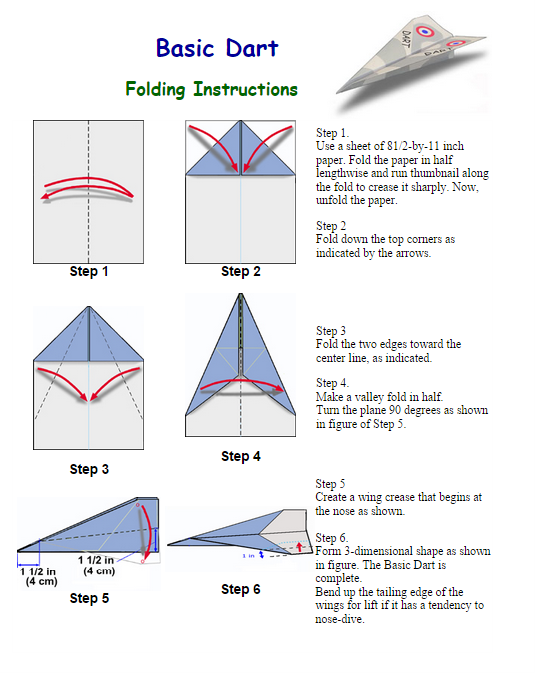Question: Does changing the type of paper affect the distance that a paper
airplane flies?
Step 1: Identify the independent and dependent variable.
I.V.:
Type of paper
D.V.:
distance the plane flies
Observations: We make observations so that we can make a hypothesis. After you
have constructed your paper airplane, fill out the observation chart.
Notebook Paper
Property Observations
|
Comparison Observations
|
·
·
The plane is soft
The plane is white The plane is thin
·
|
·
·
Feels like paper, looks like a jet
·
|
A good scientist continues to make observations. Write your
observations about the construction paper.
Construction Paper
Property Observations
|
Comparison Observations
|
·
The plane is colored
·
The plane is thick
·
The plane has rough texture
|
·
The plane looks like a jet plane
·
The plane feels like carpet texture.
·
|
Hypothesis: Which paper airplane do you
think will fly further?
If I fly the two different paper airplanes,
then whichever plane you think will fly the furthest
because and why?
Experiment/Procedure:
You
will create two paper airplanes using the same method (demonstrated by Mr. Miller).
You will make one out of printer paper and one out of construction paper. After
making a hypothesis, you will fly both of the paper airplanes to determine
which can fly further.
Data:
Type of Paper
|
Flight Distance 1 (meters)
|
Flight Distance 2 (meters)
|
Flight Distance 3 (meters)
|
Total # of Steps
|
Notebook Paper
|
||||
Construction Paper
|
Results:
Based on the total number of steps, which
plane flew the furthest:_______________________________________________________
Conclusion:
1. While we performed our experiment, was it important
that we constructed our paper airplane the exact same way each time? Why or why
not?
Yes, because we are suppose to have only 1 independent variable.
2. When we threw the paper airplanes, was it
important that the same person threw them? Why or why not?
Yes, because we are suppose to have only 1 independent variable.
3. Do you think that our experiment definitely proves
that notebook or construction paper airplanes fly further? Why or why not?
NOT A THEORY.
1. Once you finish your quiz, watch the PowerPoint below to complete your "Making a Graph of Your Data Guided Notes and CW"
NOT A THEORY.
1. Once you finish your quiz, watch the PowerPoint below to complete your "Making a Graph of Your Data Guided Notes and CW"
Review of What I Learned So Far LW
Name the piece of
lab equipment that…
1.
Is most common for holding and carrying liquids:
_______________________________
2.
Has a neck, making it useful for stirring:
___________________________
3.
We use to scoop powders:
_______________________________
4.
We use to rinse out containers:
_______________________________
5.
We use to measure volume:
_______________________________
6.
Can measure out tiny drops of water:
__________________________
7.
Can be used to heat test tubes over a flame:
____________________________
Match the lab
safety category to the rule.
8.
______ Wait before touching or tasting anything
9.
______ Wear gloves
10. ______
Waft scents to your nose
11. ______
Don’t run around the lab
12. ______
Hold equipment with both hands
a.
“Handle with care”
b.
“Wait for permission”
c.
“Keep your skin safe”
d.
“Protect your eyes and nose”
e.
“Move
carefully”
13.
Read
about the experiment below.
Daniel designed an experiment with some pet rats. He
played classical music to one group of rats, and very loud heavy music to the
other group. Then, he made his rats run in a maze. He timed how long it took
the different rats to find their way out of the maze.
Independent Variable:
____________________________________________
Dependent Variable:
______________________________________________
*Challenge - Constant Variables:
_______________________________________________
14.
Lizbeth
has five different backpacks and wants to design an experiment with them. Help
her pick a dependent variable.
Independent Variable:
_____________________________________________
What could her dependent variable be?
____________________________________


No comments:
Post a Comment